Ladders - Extension
On this page
What is an extension ladder?
Back to topExtension ladders usually have two sections that operate with brackets or guides that allow for the ladder to be used at adjustable lengths. Extension ladders are not self-supporting and require a stable structure that can withstand the intended load.
What should you do to safely secure extension ladders?
Back to top- Place ladders on a firm, level surface and ensure the footing is secure.
- Erect extension ladders so that the upper section rests on (e.g., in front of) the bottom section. This placement means the bottom section "faces" a wall or other supporting surface (see figures below).
- Place the ladder feet so that the horizontal distance between the feet and the top support is 1/4 of the working length of the ladder
(the working length is the distance along the side rail from the top support to the bottom of the ladder) . The ladder will be leaning at a 75 degree angle from the ground.
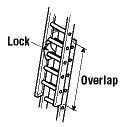
- Raise and lower ladders from the ground. Ensure that locking ladder hooks are secure before climbing.
- For access to an elevated work surface, erect ladders so that a minimum of 1 m (3 ft) extends above a landing platform. Tie the top at support points.
- Use care when getting on and or off the ladder at the top or bottom in order to avoid tipping the ladder over sideways or causing the ladder base to slide.
- Brace or tie off the ladder near the base. If there is no structure to tie off to, use a stake in the ground.
- Leave all tie-off devices in place until they must be removed before taking the ladder down.
- Maintain the minimum overlap of sections as shown on a ladder label. Refer to safety regulations.
- Set up barricades and warning signs when using a ladder in a doorway or passageway.
Note: When working 3 metres (10 feet) or more above ground, a fall protection program may be necessary. Wear a safety belt or harness with the lanyard tied appropriately to the structure. Make sure that you follow working at heights training that includes how to use fall protection devices safely.
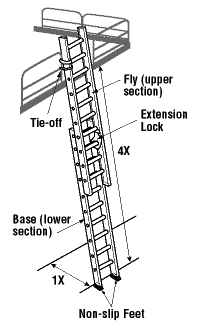
What should you avoid when using extension ladders?
Back to top- Do not use ladders near power lines. Keep ladders and other tools at least 10 feet away from power lines.
- Do not use ladders unless they have been inspected by a trained or competent person.
- Do not set up or take a ladder down when it is extended.
- Do not overextend. Maintain minimum overlap of sections.
- Do not climb higher than the fourth rung from the top of a ladder.
- Do not use ladders on ice, snow or other slippery surfaces without securing ladders' feet.
- Do not extend the top section of a ladder from above or by "bouncing" on a ladder.
- Do not leave ladders unattended.
What should you do to avoid overexertion while setting up an extension ladder?
Back to topWhen setting up an extension ladder, use the following method to avoid straining muscles or losing control of a ladder. With ladders weighing more than 25 kg (55 lb), or where conditions complicate the task, have two persons set up a ladder, step by step, as follows:
- Lay a ladder on the ground close to the intended location.
- Brace ladder base using helpers' feet.
- Grasp the top rung with both hands, raise the top end over your head and walk toward the base of a ladder. Grasp the centre of the rungs to maintain stability.
- Move the erect ladder to the desired location. Lean it forward against the resting point.
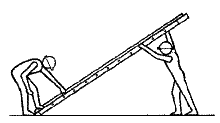
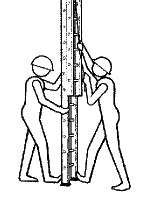
One person can erect a short ladder, step by step as follows:
- Place the bottom of a ladder firmly against the base of a building or stationary object.
- Lift the top of ladder, and pull upwards to raise a ladder to a vertical position.
- Transfer a ladder to its required position when it is erect.
- Keep a ladder upright and close to the body with a firm grip.
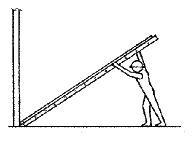
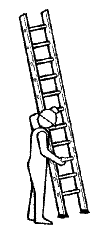
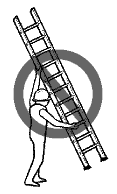
The method for lowering any ladder is the reverse procedure of erecting it.
Back to top
- Use a ladder designed for your task. Consider the strength, type, length and the Canadian Standards Association (CSA) approval.
- Read and follow all the labels and markings on the ladder.
- Make sure the load rating is indicated on the ladder and is appropriate for the user, equipment, and task.
- Inspect the ladder before and after each use.
- Reject and tag any ladders that have defects. Have faulty ladders repaired or thrown out.
- Consider having another worker hold and support the base of the ladder when needed
- Refer to safety regulations for specific measurement requirements. Refer to the CSA Z11-18 (R2022) Portable Ladders standard or the most current version for more requirements.
- Fact sheet last revised: 2025-07-10

